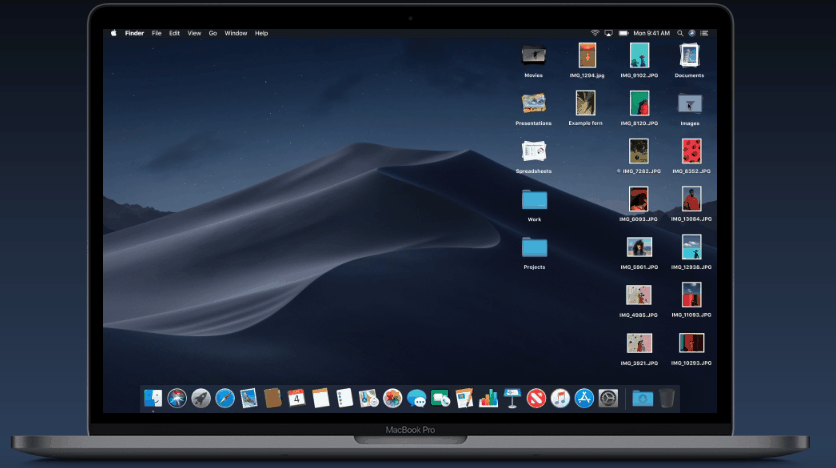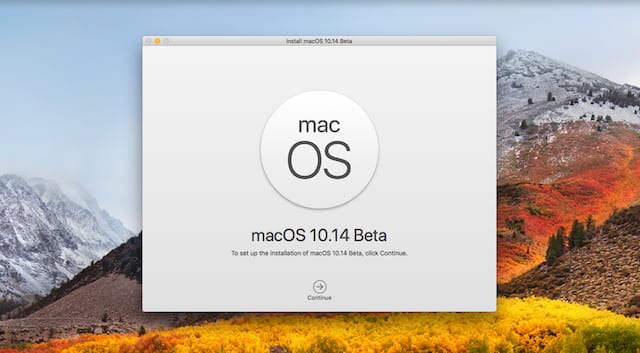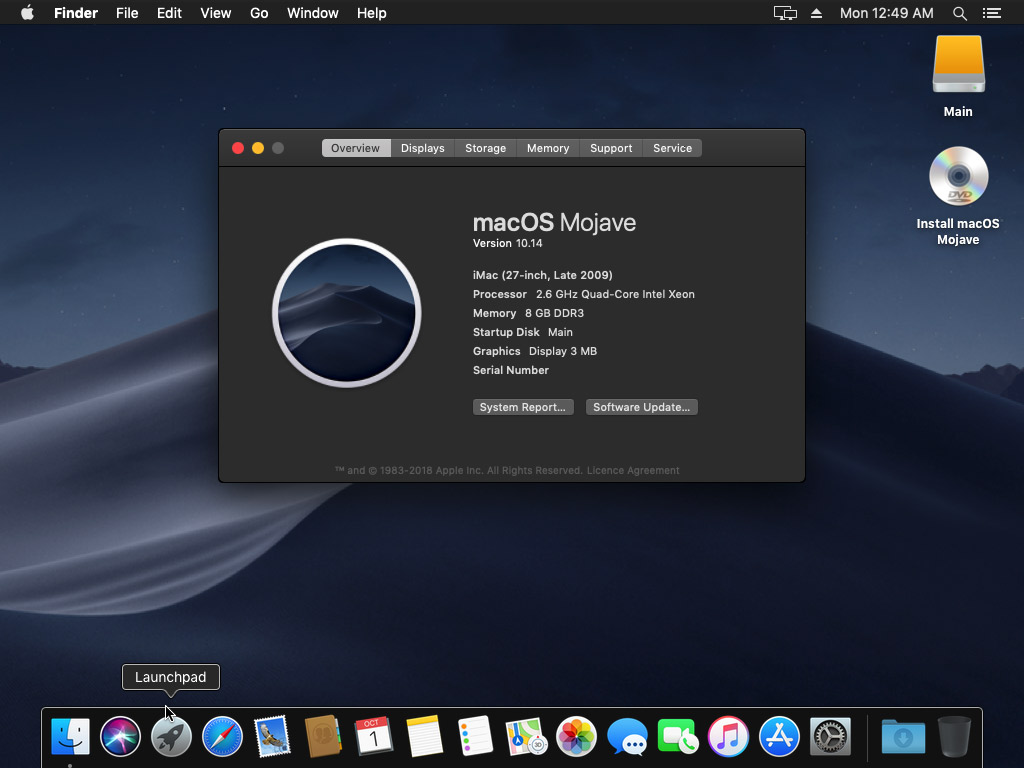In macOS Mojave, you can install Windows 10 using Boot Camp Assistant on supported Mac models. Information about products not manufactured by Apple,. Learn how to install macOS Mojave. Apple will make macOS Mojave available through the Mac App Store. The download will probably be over 2GB, and the installation will take several minutes, so use.
This is a series of tips that cover Mac OS X client edition. Server forums cover Mac OS X server on the community.
Here is the series of tips for related Macs. 10.6,10.7, 10.8, 10.9, 10.10,10.11,
10.12 ,10.13, 10.14 Mojave, 10.15 Catalina , 11.0 Big Sur.
See special note about resetting the SMC during updates and upgrades, later in the tip.
is an article I wrote that everyone updating their Mac should read. No update should be ventured into with operating systems or software without first ensuring your data is backed up in two separate places. Slowing down of your Mac should not lead you to assume an update will fix everything. First isolate why your Mac is slowing down or crashing before installing anything new.
Apple includes many full upgrade installer links on https://support.apple.com/en-us/HT211683
Note: APFS came about with High Sierra, and Mojave continues the practice of auto-reformatting drives into APFS that are solid state like flash drives from HFS Journaled. If you need to downgrade to an older system than High Sierra, you will need to reformat the drive again, or leave a partition with the old formatting available.
Apple released for 10.14.6 users, 2020-003 Mojave security update. If running an earlier version of 10.14, run the 10.14.6 Combo update first.
Apple recommends you have these Macs according to: https://support.apple.com/kb/SP777?locale=en_US
- MacBook (Early 2015 or newer) [model identifier 8,1 or later]
- MacBook Air (Mid 2012 or newer) [model identifier 5,1 or later]
- MacBook Pro (Mid 2012 or newer) [model identifier 9,1 or later]
- Mac mini (Late 2012 or newer) [model identifier 6,1 or later]
- iMac (Late 2012 or newer) [model identifier 12,1 or later]
- Mac Pro (Late 2013; Mid 2010 and Mid 2012 models with recommended Metal-capable graphics cards) [model identifier 5,1 or later]
bracketed items in quotes were added for additional identification purposes. Your Apple menu -> About This Mac -> System Report or System Profiler gives you the model identifier.
All of the Macs that are older than 10.11, need to be updated to 10.11 first before installing Mojave.
The oldest MacBook Air, Mac mini, and iMac which can upgrade to Mojave shipped with 10.8, Mountain Lion.
The oldest MacBook Pro which can upgrade to Mojave shipped with 10.7, Lion.
The oldest MacBook had Mac OS X 10.10 installed.
The oldest Mac Pro on the list above with the compatible graphics cards, had 10.6 originally installed, and is the only Mac that shipped with 10.6 that can install Mojave. Before upgrading to 10.7 or later, read this tip as Apple has not reintroduced a series of software that made older Mac compatible software compatible with Intel Macs since 10.6.8's release.
Apple released Mojave on September 24, 2018. Reports from:
earlier than that date were made with pre-release Mojave versions and can not be relied upon.
September 30, 2018 driver additions from third party update pages:
HP, and Samsung (HP has become the download site for at least some Mojave Samsung printers, if you have Samsung see if any are Catalina compatible)
Silverfast.
10.14.3 was released January 22, 2019. Note, some users are reporting 10.14.3 will not successfully apply as an update without an SMC reset as described how to do in this link: https://support.apple.com/en-us/HT201295
Frequently both updates and upgrades will require multiple reboots to successfully apply. Do NOT become impatient if you find the screen go blank during the update or upgrade process. If you press the power button to shut it down while it is rebooting for the update or upgrade, it may quit the process, and leave you stuck.
Apple Mojave Install Stuck
Use the macOS Mojave forum for operating system specific questions of other end users such as yourself.
Note: https://support.apple.com/guide/disk-utility/partition-a-physical-disk-dskutl14027/mac
are directions for creating a separate partition that will allow you to dual boot into an older operating system
if you find something not compatible with the current. Once you install the older operating system, you can use the Startup manager to dual boot to the older system.

You can't install Mojave from the Finder, unless you are running 10.13.6 or earlier.

The direct download link for Mojave is:
Install Apple Mojave Tree
Note: some people have had trouble downloading the latest Mojave links. https://brave.com/ has been found to be a better web browser than some if you run into issues and is known to work on Mac OS X 10.10 and later.
Install Apple Mojave
Note: the 2020-004 security update for Mojave has a bug with the screen saver getting stuck. To repair delays in the screen saver, 'The workaround is to choose a non-picture screen saver such as Flurry, Message, etc.' (special thanks to community member dialabrain for this report.

It’s been 20 years since macOS X first arrived. Since then, there have been 15 different versions of OS X. Some were revolutionary, while others have stayed the course.
Of course, the question for almost any Mac user is which version of OS X is best. Most machines are compatible with several versions, so you can choose.
Many people wonder about High Sierra vs Mojave. Mojave is the second-most recent version of OS X, and the last one to have support for 32-bit apps. High Sierra is the version before that, which builds on Sierra.
So, which is better? This guide will help you compare the two.
High Sierra vs Mojave
When it comes to macOS versions, Mojave and High Sierra are very comparable. The two have a lot in common, unlike Mojave and the more recent Catalina.
Like other updates to OS X, Mojave builds on what its predecessors have done. It refines Dark Mode, taking it further than High Sierra did. It also refines the Apple File System, or APFS, that Apple introduced with High Sierra.
APFS replaces the old Hierarchical File System (HFS+). It changes the way your computer organizes data. Apple had introduced it to mobile devices since it can help save space.
It also makes the process of copying files faster, among other things. True APFS functionality for fusion drives didn’t arrive until Mojave rolled out, though.
Another key difference between the two versions is support for 32-bit apps. With Mojave, Apple said they were no longer supporting 32-bit apps without compromise.
So, while a 32-bit app will still run on Mojave, it might act a bit strange. Functionality may be reduced or you may notice the app crashes a lot.
Still, Mojave will run 32-bit apps, unlike Catalina. If you want to keep running 32-bit apps without issue, though, High Sierra is your best bet. It supports 32-bit apps fully.

More Compatibility With iOS
Mojave continued the trend toward “iPadification.” More iOS apps made their way to macOS, as well as features.
High Sierra, for example, allows your Messages history to be kept in sync across devices. Mojave introduced a feature that allows you to choose your iPhone as a method of “content capture” while you’re working on your Mac.
Some iOS apps, like News, made their way to macOS with Mojave. If you’re using an older version of the OS, these apps won’t be available to you.
A True Dark Mode With Mojave
Dark Mode was first introduced in macOS El Capitan. Sierra called it “Night Shift.” High Sierra also included a Dark Mode, but users were less than impressed.
If you’re using Sierra or High Sierra, you can get more info about how to use Night Shift.
In High Sierra, the best you can get is a “dark” menu bar. Almost everything else remains bright. Even some of Apple’s own software defies dark mode and remains bright on the screen.
Mojave fixes this issue. Dark Mode now applies to every feature of every app, across the system. It’s truly a dark mode.
Many users like dark mode because it reduces eye strain. It’s particularly helpful for anyone who does a lot of work late at night or in a darkened room. Many users are familiar with dark mode from mobile apps, so they’ll be happy to see this option available.
Finder and Desktop Stacks
Other changes between High Sierra and macOS Mojave have to do with your desktop and the Finder. These features could help you stay a little more organized.
macOS Sierra had introduced Share Desktops, while Mojave introduces Desktop Stacks.
Mojave groups files, folders, and photos you drag onto your desktop. You’ll no longer need to hunt for a particular document. Instead, you can click on the relevant stack to see a list of files of that type.
Mojave also makes changes to Finder. It combines Quick Look and the Markup tools that first appeared back in 2014. You can now make changes to documents without even opening them.
Mojave also introduced Gallery View to Finder. It also makes screenshots work similar to iOS.
Which Is Better?
Mojave has some distinct advantages over High Sierra, but which one is really better? Choosing between macOS Mojave vs High Sierra depends on what you want to do with your Mac.
If you have a fusion drive, then Mojave is almost certainly the better bet for you. The refinements to APFS translate into a speedier computer and help you free up space.
If you’re a fan of dark mode, then you may well want to upgrade to Mojave. If you’re an iPhone or iPad user, then you may want to consider Mojave for the increased compatibility with iOS.
If you plan to run a lot of older programs that don’t have 64-bit versions, then High Sierra is probably the right choice. If you’re not concerned with integration between your iPhone and your Mac, then High Sierra could be the right choice.
Is Your Computer Compatible?
Before you decide to install either High Sierra or Mojave, you should make sure your computer is compatible.
Mojave will run on most Mac computers newer than 2012, with a few exceptions. MacBooks will need to be 2015 or newer, while iMac Pro computers will need to be 2017 or newer.
Mac Pro models from late 2013, mid-2012, and mid-2010 will also run Mojave. Most Macs from 2009 or 2010 will run High Sierra.
Get the Most out of Your Mac
If you’re not ready to make the leap to macOS Catalina, then Mojave or High Sierra could be the right choice. The winner of High Sierra vs Mojave depends on what features you want to see in your operating system.
As Apple keeps upgrading its OS, it’s bringing more apps to desktop platforms. Wondering if it’s a good idea to invest in a mobile app for your business? Discover how this and other tech can help you grow.
Related Posts
2 - 2
